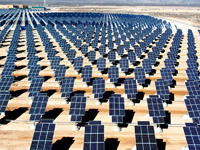Solar Energy
Generating Electricity with Photovoltaic Cells
One way to convert solar energy into electricity is through photovoltaic cells. The word photovoltaic is derived from the Greek world phos, which means "light," and the word volt which is a unit of measure for electricity. A photovoltaic panel can produce differing amounts of electricity depending on the intensity of the sunlight, the number of cells on the panel, and how the cells are connected together. Photovoltaics, also known as PV cells, are becoming more and more familiar in our everyday landscape. The more cells you put together, the more power you can generate.
|
When sunlight hits the photovoltaic cell… • The n-type silicon layer releases electrons because it is "doped" with an element that has one too many electrons for its outer shell. • The "extra electrons leave the n-side and find new "homes in the p-side, which is doped with an element that has one less electron than fits in the outer shell, thus making an electric field. • A photon of just the right energy hits the p-side and knocks the electrons out of the adopted homes, so that they "notice" that they are in an electric field, which makes them move. • Rather than letting them go directly back to the n-side, they are diverted through a wire, making an electric current that can be used. |
||||||




